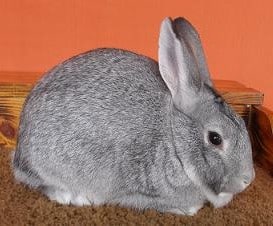Type the name of the breed you're looking for below
[wpdreams_ajaxsearchlite] Don't see the breed your're looking for? Click here and let us know!
Breed Characteristics
1 paw - breed exhibits the least amount of this characteristic
5 paws - breed exhibits most amount of this characteristic
Standard Chinchilla rabbit
| Origin | Developed from the cross of a wild gray and domestic rabbit in 1913, it derived its name from the color of its fur. They are not related to and cannot interbreed with chinchillas, which are a species of rodent. Rabbits are lagomorphs. A mutation diluted the yellow pigment in the hairs to almost white, changing in this way the color of the fur of the wild rabbit (agouti) into chinchilla. The Standard Chinchilla is both an attractive rabbit and one of the most important breeds to the development of the American rabbit fancy. The standout feature of this breed is its dense rollback coat, colored a wavy blend of black and white. Its six-pound size makes it very easy to handle: not too heavy, and not too small and delicate. The size also makes it ideal for a small family wanting to put a little rabbit meat on the table. As an extra bonus, Standard Chinchillas have docile, friendly temperaments, making them suitable pets for children and adults. There are three Chinchilla breeds recognized in the United States, but the Standard was the first. It’s the ancestor of not only the other “Chin” breeds, but also the color chinchilla that appears as a variety in some other breeds. The color first appeared in 1919 in France, with genes of the blue Beveren, Himalayan, and a wild rabbit contributing to its makeup. Instantly breeders saw its value as a fur animal. The new breed caused a sensation that spread nearly everywhere rabbits were raised, but nowhere did it attract so much attention as in the United States. Chinchillas were the “next big thing” after the Belgian Hare. Commercial operations were set up to produce them in mass. In the 1920’s, thousands and thousands of Chinchillas were registered with the organization that would become the American Rabbit Breeders Association. But as soon as Chinchillas hit the American shores, business-minded fanciers decided they weren’t good enough. Standard Chins were only about six pounds; the breeders wanted a bigger breed to meet the demands of the fur market. Almost immediately they set out to produce the American Heavyweight and the Giant Chinchilla. All three breeds were recognized by 1930. Today the Standard Chinchilla still lives under the shadow of the Giant and American versions. It’s strange, because although the Standard consistently has a larger number of breeders, the Giant and American Chins get much more publicity. Both the two larger breeds are considered rare by the American Livestock Breeds Conservancy, which helps them gain extra attention. There’s no danger of the Standard version dropping out of sight yet, but if we aren’t careful to preserve it, we might lose the “Granddaddy Chin” while trying to protect its descendants. |
Physical Attributes
| Weight | 5 - 7.5 lbs. (2.3 - 3.4 kg) |
| Ear Type | Erect |
| Fur Type | Rollback |
| Colours | Base of each hair is slate blue. intermediate band is pearl, top band is black. |
| Appearance | Medium length body with well rounded hindquarters. |
| Other Considerations | Life Expectancy: 5-8 years Temperament: Docile |
| Best Kept In | Pen. Cage or Yard. |



